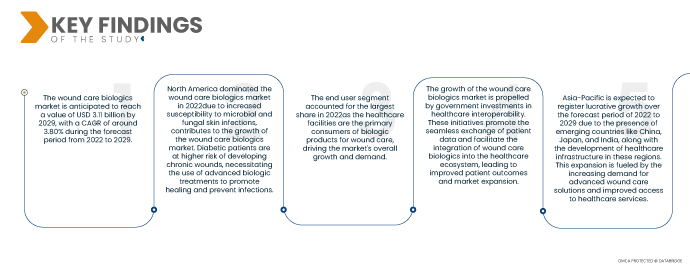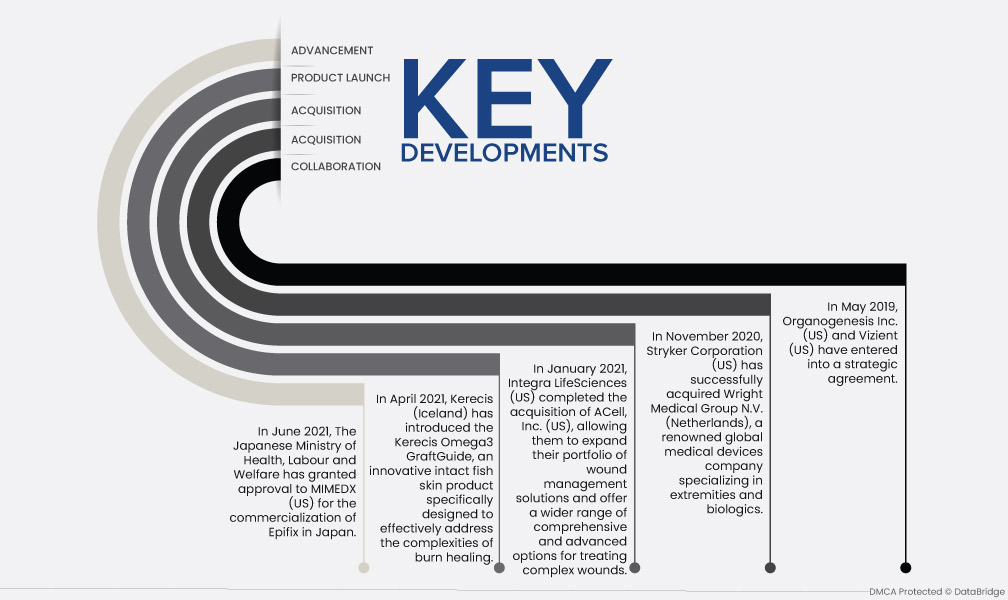The process of wound healing is intricate, involving the coordination and activation of various elements within and between cells. These include collagen coagulation and deposition, epithelialization, fibrous tissue growth, wound contraction, inflammation, granulation, and remodeling. Wound care biologics, which are products created through biological engineering, are specifically designed to address non-healing lower extremity wounds. They find application in the treatment of diabetic foot ulcers, pressure ulcers, surgical wounds, and venous leg ulcers, among others.
Access Full Report at https://databridgemarketresearch.com/reports/global-wound-care-biologics-market
Data Bridge Market Research analyses that the Wound Care Biologics Market is valued at USD 2.23 billion in 2021 and is expected to reach USD 3.11 billion by 2029, registering a CAGR of 3.80% during the forecast period of 2022 to 2029. The use of wound care biologics can contribute to cost-effectiveness by promoting faster wound healing, reducing the risk of complications, and potentially decreasing hospital stay duration. This focus on cost containment and improved patient outcomes has fueled the adoption of wound care biologics.
Key Findings of the Study
The increasing burden of targeted diseases is expected to drive the market's growth rate
The escalating incidence of diabetes plays a pivotal role in driving the growth of the wound care biologics market. Diabetes is a leading cause of chronic wounds, such as diabetic foot ulcers, which often require advanced biologic therapies to promote healing. As the prevalence of diabetes continues to rise globally, there is a growing demand for effective wound care solutions, fueling the expansion of the wound care biologics market to address the specific needs of diabetic patients.
Report Scope and Market Segmentation
|
Report Metric
|
Details
|
|
Forecast Period
|
2022 to 2029
|
|
Base Year
|
2021
|
|
Historic Years
|
2020 (Customizable to 2014-2019)
|
|
Quantitative Units
|
Revenue in USD Billion, Volumes in Units, Pricing in USD
|
|
Segments Covered
|
Product (Biologic Skin Substitutes, Topical Agents), Wound Type (Ulcers, Surgical, and Traumatic Wounds, Burns), End User (Hospitals, ASCs, Burn Centres and Wound Clinics)
|
|
Countries Covered
|
U.S., Canada and Mexico in North America, Germany, France, U.K., Netherlands, Switzerland, Belgium, Russia, Italy, Spain, Turkey, Rest of Europe in Europe, China, Japan, India, South Korea, Singapore, Malaysia, Australia, Thailand, Indonesia, Philippines, Rest of Asia-Pacific (APAC) in the Asia-Pacific (APAC), Saudi Arabia, U.A.E, South Africa, Egypt, Israel, Rest of Middle East and Africa (MEA) as a part of Middle East and Africa (MEA), Brazil, Argentina and Rest of South America as part of South America.
|
|
Market Players Covered
|
Smith & Nephew (U.K.), Mölnlycke Health Care AB (Sweden), Integra LifeSciences Corporation (U.S.), Wright Medical (U.S.), MiMedx Group (U.S.), Vericel Corporation (U.S.), Anika Therapeutics (U.S.), Osiris Therapeutics (U.S.), Organogenesis (U.S.), Kerecis (Iceland), Solsys Medical (U.S.), ACell (U.S.), Lavior Inc. (U.S.). Marine Polymer Technologies, Inc. (U.S.), Smith & Nephew (U.K.), Mölnlycke Health Care AB (Sweden))
|
|
Data Points Covered in the Report
|
In addition to the insights on market scenarios such as market value, growth rate, segmentation, geographical coverage, and major players, the market reports curated by the Data Bridge Market Research also include depth expert analysis, patient epidemiology, pipeline analysis, pricing analysis, and regulatory framework
|
Segment Analysis:
The wound care biologics market is segmented on the basis of product, wound type, and end user.
- On the basis of product, the wound care biologics market is segmented into biologic skin substitutes and topical agents. In 2022 biologic skin substitutes segment in global wound care biologics as they provide a supportive environment for cell growth and tissue regeneration, promoting faster and more efficient wound healing.
In 2022, the biologic skin substitutes segment is dominating the product segment of the global wound care biologics market
In 2022 biological skin substitutes segment is dominating the market it has various applications in wound care biologics. They can be used for the treatment of burns, chronic wounds, and large traumatic injuries. These grafts provide a temporary or permanent barrier that protects the wound from infection, promotes cell proliferation and migration, and supports tissue regeneration.
- On the basis of wound type, the wound care biologics market is ulcers, surgical and traumatic wounds and burns. In 2022, the ulcer segment dominates and is growing at the highest CAGR of 11.4% as wound care biologics are widely used in the treatment of ulcers, such as diabetic foot ulcers and venous leg ulcers.
- On the basis of end user, the wound care biologics market is segmented into hospitals, ASCs, burn centers, and wound clinics. In 2022 hospital segment is rising at the highest CAGR of 11.4% as they provide a supportive environment for tissue regeneration, reduce inflammation, and enhance the formation of new blood vessels
In 2022, the hospital segment is dominating the end user of the global wound care biologics market
In 2022 hospital segment is dominating the application segment of the global wound care biologics market Wound care biologics play a significant role in hospitals for the management of complex wounds. These biologics, such as growth factors, bioengineered tissues, and extracellular matrices, are used to promote healing in chronic wounds, diabetic ulcers, surgical wounds, and pressure sores.
Major Players
Data Bridge Market Research recognizes the following companies as the major wound care biologics market players in wound care biologics market are Smith & Nephew (U.K.), Mölnlycke Health Care AB (Sweden), Integra LifeSciences Corporation (U.S.), Wright Medical (U.S.), MiMedx Group (U.S.)
Market Developments
- In June 2021, The Japanese Ministry of Health, Labour and Welfare has granted approval to MIMEDX (US) for the commercialization of Epifix in Japan.
- In April 2021, Kerecis (Iceland) has introduced the Kerecis Omega3 GraftGuide, an innovative intact fish skin product specifically designed to effectively address the complexities of burn healing.
- In January 2021,
- Integra LifeSciences (US) completed the acquisition of ACell, Inc. (US), allowing them to expand their portfolio of wound management solutions and offer a wider range of comprehensive and advanced options for treating complex wounds.
- In November 2020, Stryker Corporation (US) has successfully acquired Wright Medical Group N.V. (Netherlands), a renowned global medical devices company specializing in extremities and biologics. This acquisition strengthens Stryker's position in these fields, enabling them to provide enhanced medical solutions to patients worldwide.
- In May 2019, Organogenesis Inc. (US) and Vizient (US) have entered into a strategic agreement. This partnership enables Organogenesis to expand its range of advanced wound care products to over 3,100 hospitals, thus providing broader access to these innovative solutions for improved patient care.
Regional Analysis
Geographically, the countries covered in the wound care biologics market report are U.S., Canada and Mexico in North America, Germany, France, U.K., Netherlands, Switzerland, Belgium, Russia, Italy, Spain, Turkey, Rest of Europe in Europe, China, Japan, India, South Korea, Singapore, Malaysia, Australia, Thailand, Indonesia, Philippines, Rest of Asia-Pacific (APAC) in the Asia-Pacific (APAC), Saudi Arabia, U.A.E, South Africa, Egypt, Israel, Rest of Middle East and Africa (MEA) as a part of Middle East and Africa (MEA), Brazil, Argentina and Rest of South America as part of South America.
As per Data Bridge Market Research analysis:
North America is the dominant region in the wound care biologics market during the forecast period 2022 - 2029
In 2022, North America dominated the wound care biologics market escalating prevalence of diabetic foot ulcers and the heightened susceptibility to microbial and fungal skin infections are contributing factors driving the demand for effective treatments. These conditions pose significant healthcare challenges due to their impact on patient quality of life and potential complications. Addressing these challenges requires innovative approaches in wound care management, focusing on prevention, early detection, and advanced treatments to mitigate the burden of these conditions and improve patient outcomes.
Asia-Pacific is estimated to be the fastest growing region in the wound care biologics market in the forecast period 2022 - 2029
In 2022, Asia-Pacific is expected to grow during the forecast period due to the presence of emerging countries like China, Japan, and India, coupled with their developing healthcare infrastructure, contributing to the growth potential in addressing diabetic foot ulcers and skin infections. These countries have witnessed economic advancements and increased healthcare investments, creating opportunities for improved access to medical services and advanced wound care technologies. This progress enables better management of these conditions and fosters the development of innovative solutions to meet the growing healthcare needs in these regions.
For more detailed information about the wound care biologics market report, click here – https://www.databridgemarketresearch.com/reports/global-wound-care-biologics-market













